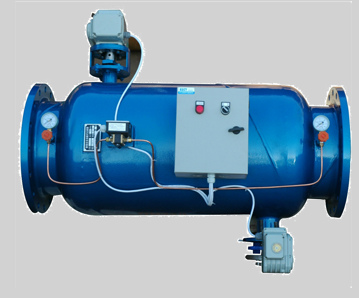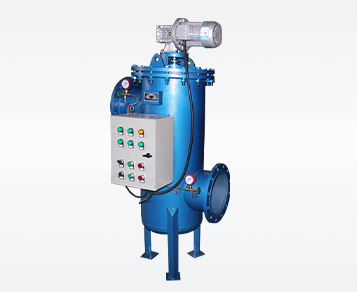1. Product Introduction
A self - cleaning filter is an advanced and automated filtration device designed to continuously remove contaminants from fluids while maintaining high - flow efficiency without the need for frequent manual intervention. Unlike traditional filters that require periodic disassembly and cleaning, self - cleaning filters use integrated mechanisms to clean the filter media during operation, significantly reducing downtime, labor costs, and maintenance efforts.
These filters are constructed from high - quality materials such as stainless steel, which provides excellent resistance to corrosion, abrasion, and high - pressure environments. They are capable of handling a wide range of fluids, including water, chemicals, oils, and industrial slurries. Self - cleaning filters are available in various configurations and sizes to suit different application requirements, making them a versatile solution for both industrial and commercial filtration needs.

2. Working Principle
The working principle of a self - cleaning filter revolves around the combination of filtration and automated cleaning processes. When the contaminated fluid enters the filter, it passes through the filter media, which traps particles and debris based on its pore size. The clean fluid then exits the filter through the outlet, while the contaminants accumulate on the surface of the filter media.
Once the differential pressure across the filter media reaches a pre - set threshold (indicating a significant accumulation of contaminants), the self - cleaning process is initiated. There are several common cleaning mechanisms:
Scraping Mechanism: In filters with this mechanism, a set of scrapers or blades moves along the surface of the filter media. As they rotate or reciprocate, the scrapers dislodge the accumulated contaminants from the media surface. The dislodged particles are then flushed out of the filter through a 排污口,usually with the help of a backwash flow of clean fluid or a portion of the filtered fluid.
Backwashing Mechanism: For filters using backwashing, clean fluid is directed in the opposite direction of the normal flow through the filter media. This reverse flow exerts a force on the contaminants, pushing them off the surface of the media and carrying them away through a dedicated drain line. The backwashing process can be either a short - duration, high - flow burst or a continuous, lower - flow process, depending on the filter design.
Brushing Mechanism: Some self - cleaning filters employ brushes that rotate or move across the filter media surface. The brushes physically scrub the media, removing the deposited contaminants, which are subsequently washed away by a flushing fluid.
After the cleaning process is completed, the filter resumes its normal filtration operation, ready to trap more contaminants and maintain the fluid's cleanliness.
3. Technical Parameters
3.1 Filtration Precision
Self - cleaning filters can achieve a wide range of filtration precisions, typically from 5 microns to 5000 microns. The choice of filtration precision depends on the specific application requirements. For applications where fine particle removal is crucial, such as in pharmaceutical or semiconductor manufacturing, filters with a precision of 5 - 50 microns are commonly used. In contrast, for industrial wastewater treatment or coarse - filtration in mining operations, filters with a coarser precision of 100 - 5000 microns may be sufficient.
3.2 Flow Rate
The flow rate capacity of self - cleaning filters varies greatly, ranging from 1 cubic meter per hour for small - scale units to over 10,000 cubic meters per hour for large industrial - grade filters. The flow rate is determined by factors such as the size of the filter, the type of filter media, and the design of the cleaning mechanism. Larger filters with more extensive filter media surface areas and optimized cleaning systems can handle higher flow rates while maintaining efficient filtration.
3.3 Pressure Rating
Self - cleaning filters are designed to operate under different pressure conditions. Most standard models have a pressure rating ranging from 0.1 MPa to 2.5 MPa. However, for applications in high - pressure systems, such as oil and gas pipelines or high - pressure water jetting, specialized filters with higher pressure ratings of up to 10 MPa or more are available.
3.4 Cleaning Cycle Time
The cleaning cycle time, which is the time interval between successive cleaning operations, can be adjusted according to the operating conditions. It typically ranges from a few minutes to several hours. In applications with high - contaminant loads, the cleaning cycle time may be set to be shorter to ensure continuous efficient filtration. Conversely, in relatively clean fluid applications, a longer cleaning cycle time can be used to reduce wear and tear on the cleaning components.

4. Working Components
4.1 Filter Housing
The filter housing is the outer shell of the self - cleaning filter, which provides structural support and contains the filter media and cleaning components. It is usually made of stainless steel or other corrosion - resistant materials to withstand harsh operating environments. The housing is designed with inlet and outlet ports for the fluid, as well as a drain port for the removal of contaminants during the cleaning process.
4.2 Filter Media
The filter media is the core component responsible for trapping contaminants. It can be made of various materials, including stainless - steel mesh, sintered metal, synthetic fibers, or ceramic. The choice of filter media depends on factors such as the type of fluid, the required filtration precision, and the chemical compatibility. Different filter media have different pore structures and surface properties, which affect their filtration efficiency and dirt - holding capacity.
4.3 Cleaning Mechanism Components
As mentioned earlier, depending on the type of cleaning mechanism, the filter contains components such as scrapers, brushes, or backwash nozzles. These components are precisely engineered to ensure effective cleaning of the filter media. They are driven by motors, pneumatic actuators, or hydraulic systems, which control their movement and operation during the cleaning process.
4.4 Control System
The control system is an essential part of the self - cleaning filter, which monitors the differential pressure across the filter media and initiates the cleaning process when necessary. It can be a simple mechanical pressure - sensing device or a more advanced programmable logic controller (PLC) - based system. The control system also allows for the adjustment of parameters such as the cleaning cycle time, cleaning duration, and backwash flow rate, providing flexibility and adaptability to different operating conditions.
5. Application Areas
5.1 Water Treatment
In water treatment plants, self - cleaning filters are used for pre - filtration of raw water, removing suspended solids, algae, and other contaminants before further treatment processes such as sedimentation, disinfection, and reverse osmosis. They are also employed in industrial cooling water systems to prevent the accumulation of debris, which can cause fouling and reduced heat transfer efficiency in heat exchangers.
5.2 Oil and Gas Industry
In the oil and gas sector, self - cleaning filters are used to filter drilling fluids, removing drill cuttings and other solids to maintain the performance of the drilling equipment. They are also applied in the filtration of process fluids in refineries and petrochemical plants, separating contaminants from crude oil, refined products, and chemicals, ensuring the smooth operation of pipelines, pumps, and other equipment.
5.3 Chemical Industry
In chemical manufacturing, self - cleaning filters are used to filter raw materials, intermediate products, and final products. They help to remove impurities, catalysts, and by - products, ensuring product quality and preventing damage to downstream equipment. For example, in the production of polymers, self - cleaning filters are used to remove particulate matter from the polymer melt, improving the quality of the final product.
5.4 Food and Beverage Industry
In the food and beverage industry, self - cleaning filters play a crucial role in maintaining product quality. They are used to filter process water, edible oils, fruit juices, and other liquids, removing any unwanted particles, debris, or contaminants. These filters meet strict hygiene standards and are designed to prevent cross - contamination, ensuring the safety and quality of food and beverage products.
In conclusion, self - cleaning filters are highly efficient and reliable filtration devices that offer significant advantages in terms of continuous operation, reduced maintenance, and adaptability to various applications. Their unique working principle, comprehensive technical parameters, and well - designed working components make them an ideal choice for a wide range of industries where fluid filtration is required.
{sval:sql sql='SELECT n_parameter FROM dede_addonarticle WHERE aid = ~aid~ ' } {/sval:sql}
{sval:sql sql='SELECT n_parameter FROM dede_addonarticle WHERE aid = ~aid~ ' } {/sval:sql}




















